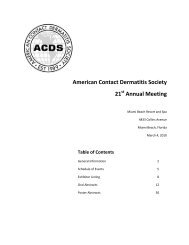2006 Abstracts - American Contact Dermatitis Society
2006 Abstracts - American Contact Dermatitis Society
2006 Abstracts - American Contact Dermatitis Society
- No tags were found...
You also want an ePaper? Increase the reach of your titles
YUMPU automatically turns print PDFs into web optimized ePapers that Google loves.
FIXED DRUG ERUPTION DUE TO METAMIZOLE (NOLOTIL®): THEUSEFULNESS OF PATCH TESTJoan Dalmau, Esther Serra-Baldrich, Esther Roé, Agustín Alomar.Dermatology Department. Hospital de la Santa creu i Sant Pau. Barcelona.Keywords: Fixed drug eruption, metamizole, patch test.Fixed drug eruption(FDE) is an adverse cutaneous drug reaction. It ischaracterised by itching, erythematous macules repeatedly appearing in the sameareas, after to be exposed to an oral medication, leaving residual hyperpigmentedlesions once the drug has been withdrawn.We present a 39-year-old woman with a FDE secondary tometamizole.Patch tests with the standard and NSAID batteries were negative.Liquid Nolotil® (metamizole) was applied occlusively on the back, in the areawhere the FDE presented initially, with a positive skin reaction (++).Nolotil®applied on the arm -an area free of FDE lesions when the patient came to theclinic- was negative. One month later, occlusive 1% metamizol in petrolatum wasapplied to the back area where the FDE first appeared, and gave a positive skinreaction (++) again.The FDE diagnosis is based on clinical evaluation and the oral provocationtest. To make the etiologic diagnosis, topic provocation test has been used insteadof the oral provocation in the areas where the lesions appeared for the first time. Insome cases of FDE due to metamizole the topical provocation test with this drughas been reported to be positive in the area where the lesion first appeared. Werecommend the patch test with occlusive application of 1% metamizole inpetrolatum, as the first diagnostic step in FDE cases due to metamizole, especiallywhen the patient rejects the oral provocation test or when the test can reproduceunwanted side effects.A CASE OF COMPOSTIAE AIRBORNE DERMATITIS EXACERBATED BYMOISTURIZER CONTAINING FEVERFEW.Christina Killoran MD, Anita Pedvis-Leftick MD. Roger Williams Department ofDermatology and Skin Surgery, Providence, RI.A 45 year old woman presented in October with a history of an eruptioninvolving her scalp and face including behind her ears and eyelids. The eruptionbegan at the end of August. It flared after she used Aveeno Calming moisturizerwhich contains feverfew. The patient was advised to stop all skin care productsand was switched to Vani products. She was treated with a course of mid-potencytopical steroids with almost complete resolution of the eruption. She was patchtested to the North <strong>American</strong> <strong>Contact</strong> <strong>Dermatitis</strong> Series. She had a 1+ reaction tosesquiterpene lactone mix, 1+ reaction to Compositae mix, 1+ reaction toparthenolide, 1+ reaction to tanacetum vulgare and a 1+ reaction to AveenoCalming Moisturizer. It is felt that her dermatitis is a result of airborne contactdermatitis to pollens of the Compositae family. The eruption was exacerbated byher use of the Aveeno Calming moisturizer which contains feverfew.38






